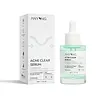What's inside
What's inside
 Key Ingredients
Key Ingredients

 Benefits
Benefits

 Concerns
Concerns

 Ingredients Side-by-side
Ingredients Side-by-side

Water
Skin ConditioningPolyglycerin-6
HumectantAzelaic Acid
BufferingNiacinamide
SmoothingPanthenol
Skin ConditioningSodium Hyaluronate
HumectantPotassium Sorbate
PreservativeAllantoin
Skin ConditioningGlycine
BufferingSodium PCA
HumectantSodium Lactate
BufferingArginine
MaskingProline
Skin ConditioningThreonine
PCA
HumectantAlanine
MaskingAspartic Acid
MaskingIsoleucine
Skin ConditioningSerine
MaskingValine
MaskingHistidine
HumectantPhenylalanine
MaskingHydroxyethylcellulose
Emulsion StabilisingSodium Benzoate
MaskingTetrasodium EDTA
Water, Polyglycerin-6, Azelaic Acid, Niacinamide, Panthenol, Sodium Hyaluronate, Potassium Sorbate, Allantoin, Glycine, Sodium PCA, Sodium Lactate, Arginine, Proline, Threonine, PCA, Alanine, Aspartic Acid, Isoleucine, Serine, Valine, Histidine, Phenylalanine, Hydroxyethylcellulose, Sodium Benzoate, Tetrasodium EDTA
Water
Skin ConditioningCentella Asiatica Leaf Extract
Skin ConditioningBacillus
Skin ConditioningAzelaic Acid
BufferingPropylene Glycol
HumectantAloe Barbadensis Leaf Juice
Skin ConditioningSodium Hyaluronate
HumectantPentylene Glycol
Skin ConditioningSalix Alba Bark Extract
AstringentPanthenol
Skin ConditioningMadecassic Acid
Skin ConditioningAsiaticoside
AntioxidantAsiatic Acid
Skin ConditioningInulin
Skin ConditioningFructose
HumectantHydroxyethylcellulose
Emulsion Stabilising1,2-Hexanediol
Skin ConditioningCaprylyl Glycol
EmollientSorbitol
HumectantSpirulina Platensis Extract
Skin ProtectingPotassium Sorbate
PreservativeEthylhexylglycerin
Skin ConditioningWater, Centella Asiatica Leaf Extract, Bacillus, Azelaic Acid, Propylene Glycol, Aloe Barbadensis Leaf Juice, Sodium Hyaluronate, Pentylene Glycol, Salix Alba Bark Extract, Panthenol, Madecassic Acid, Asiaticoside, Asiatic Acid, Inulin, Fructose, Hydroxyethylcellulose, 1,2-Hexanediol, Caprylyl Glycol, Sorbitol, Spirulina Platensis Extract, Potassium Sorbate, Ethylhexylglycerin
 Reviews
Reviews

Ingredients Explained
These ingredients are found in both products.
Ingredients higher up in an ingredient list are typically present in a larger amount.
Azelaic acid is a multitasker ingredient that helps treat acne, pigmentation, and irritation. It is a great option for sensitive skin.
What makes azelaic special?
The best thing about azelaic acid is it's gentleness. It's generally well-tolerated and safe to use alongside other actives like niacinamide or salicylic acid.
Unlike AHAs, azelaic acid will not make you photosensitive/sun sensitive.
You can find this ingredient naturally occurring in grains like wheat, rye, and barley. In cosmetics, azelaic acid is typically lab-made, which is more stable and effective.
Learn more about Azelaic AcidHydroxyethylcellulose is used to improve the texture of products. It is created from a chemical reaction involving ethylene oxide and alkali-cellulose. Cellulose is a sugar found in plant cell walls and help give plants structure.
This ingredient helps stabilize products by preventing ingredients from separating. It can also help thicken the texture of a product.
This ingredient can also be found in pill medicines to help our bodies digest other ingredients.
Learn more about HydroxyethylcellulosePanthenol is a common ingredient that helps hydrate and soothe the skin. It is found naturally in our skin and hair.
There are two forms of panthenol: D and L.
D-panthenol is also known as dexpanthenol. Most cosmetics use dexpanthenol or a mixture of D and L-panthenol.
Panthenol is famous due to its ability to go deeper into the skin's layers. Using this ingredient has numerous pros (and no cons):
Like hyaluronic acid, panthenol is a humectant. Humectants are able to bind and hold large amounts of water to keep skin hydrated.
This ingredient works well for wound healing. It works by increasing tissue in the wound and helps close open wounds.
Once oxidized, panthenol converts to pantothenic acid. Panthothenic acid is found in all living cells.
This ingredient is also referred to as pro-vitamin B5.
Learn more about PanthenolPotassium Sorbate is a preservative used to prevent yeast and mold in products. It is commonly found in both cosmetic and food products.
This ingredient comes from potassium salt derived from sorbic acid. Sorbic acid is a natural antibiotic and effective against fungus.
Both potassium sorbate and sorbic acid can be found in baked goods, cheeses, dried meats, dried fruit, ice cream, pickles, wine, yogurt, and more.
You'll often find this ingredient used with other preservatives.
Learn more about Potassium SorbateSodium Hyaluronate is hyaluronic acid's salt form. It is commonly derived from the sodium salt of hyaluronic acid.
Like hyaluronic acid, it is great at holding water and acts as a humectant. This makes it a great skin hydrating ingredient.
Sodium Hyaluronate is naturally occurring in our bodies and is mostly found in eye fluid and joints.
These are some other common types of Hyaluronic Acid:
Learn more about Sodium HyaluronateWater. It's the most common cosmetic ingredient of all. You'll usually see it at the top of ingredient lists, meaning that it makes up the largest part of the product.
So why is it so popular? Water most often acts as a solvent - this means that it helps dissolve other ingredients into the formulation.
You'll also recognize water as that liquid we all need to stay alive. If you see this, drink a glass of water. Stay hydrated!
Learn more about Water